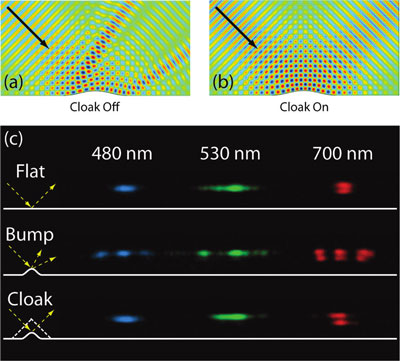| Posted: Aug 03, 2011 | |
New cloaking material hides objects otherwise visible to the human eye |
|
| (Nanowerk Spotlight) Exotic artificial composite materials called metamaterials can be engineered with certain electromagnetic properties that allows them to act as invisibility cloaks. These materials bend all light or other electromagnetic waves around an object hidden inside a metamaterial cloak, to emerge on the other side as if they had passed through an empty volume of space. | |
| Researchers have already been experimenting with cloaking devices for various, usually longer wavelengths such as microwave or infrared waves (see for instance: "Researchers demonstrate next generation cloaking device"). Recently, even graphene has been added to the family of cloaking materials ("A single layer of graphene is the thinnest possible invisibility cloak"). | |
| Now, for the first time, a team of scientists at UC Berkeley have devised an invisibility cloak material that hides objects from detection using light that is visible to humans. They have reported their work in a recent issue of Nano Letters ("A Carpet Cloak for Visible Light"). This work makes actual invisibility for the light seen by the human eye possible. | |
| "The cloaking device we made in our group demonstrates that we are now able to control the flow of light in the desired paths for the whole spectrum of visible light," Majid Gharghi, a postdoctoral fellow in Xiang Zhang's lab at UC Berkeley, tells Nanowerk. "It is a proof of concept that invisibility and other optical illusion phenomena can be achieved with visible light." | |
 |
|
| Simulated propagation of a Gaussian beam when reflected from a bumped carpet (a) without and (b) with a cloaking device on top of the carpet. The input beam indicated by the black arrow has a wavelength of 600 nm. The perturbation caused by the bump is masked by the cloak device and the reflected beam is reconstructed as if the bump did not exist. (c) Experimental results: normalized intensity CCD images of the out-coupled light (shown in false color) from the waveguide after reflection from a flat mirror, bump without a cloak, and cloaked bump at three different wavelengths. The bump clearly distorts the wavefront, creating a lobed pattern. The cloak successfully reconstructs the wavefront so that the output is unperturbed. (Reprinted with permission from American Chemical Society) | |
| He explains that invisibility cloaks usually require electromagnetic properties with extreme values that are only achievable in metallic metamaterials and have been experimentally demonstrated for cloaking at microwave frequencies. | |
| "Because of the significant metallic loss at optical frequencies, the implementation of invisibility cloaks for visible light has been difficult" says Gharghi. "The cloak we designed uses quasi conformal mapping (QCM) and is fabricated in a silicon nitride waveguide on a specially developed nanoporous silicon oxide substrate with an exceptionally low refractive index of less than 1.25; both the waveguide and the substrate are transparent. This unique substrate increases the available index modulation and enables the implementation of transformation optics for guided visible light." | |
| The carpet cloak works by concealing an object under the layers, and bending light waves away from the bump that the object makes, so that the cloak appears flat and smooth like a normal mirror. | |
| According to the researchers, there are still some problems that need to be solved. To achieve the cloaking effect for the full visible range, they need to employ nanofabrication techniques to make the required metamaterials. Today, these are still difficult and time consuming processes, and therefore, the cloak the team demonstrated is very small, 6 micrometers wide and 300nm tall – barely enough to cloak a red blood cell. | |
| "To cloak a large object, the difficulty and complexity of the nanofabrication processes grow proportionally, and that is the main bottleneck towards large scale invisibility" says Gharghi. "The most significant challenge will be large-scale and three-dimensional manufacturing that enables up-scaling of metamaterial fabrication techniques. Also, new materials systems need to be engineered that can provide the range of optical properties required for achieving some of the more sophisticated optical phenomena." | |
| Besides rendering objects invisible and creating other optical illusions, the use of metamaterials to control the flow of light can have many applications in the fields of energy, medical imaging, information technology, etc. Examples are using transformation optics and metamaterials for better use of solar light in energy devices; for elimination of sources of noise in imaging and microscopy; and for controlling on-chip propagation of optical signals. | |
 By
Michael
Berger
– Michael is author of three books by the Royal Society of Chemistry:
Nano-Society: Pushing the Boundaries of Technology,
Nanotechnology: The Future is Tiny, and
Nanoengineering: The Skills and Tools Making Technology Invisible
Copyright ©
Nanowerk LLC
By
Michael
Berger
– Michael is author of three books by the Royal Society of Chemistry:
Nano-Society: Pushing the Boundaries of Technology,
Nanotechnology: The Future is Tiny, and
Nanoengineering: The Skills and Tools Making Technology Invisible
Copyright ©
Nanowerk LLC
|
|
|
Become a Spotlight guest author! Join our large and growing group of guest contributors. Have you just published a scientific paper or have other exciting developments to share with the nanotechnology community? Here is how to publish on nanowerk.com. |
|
